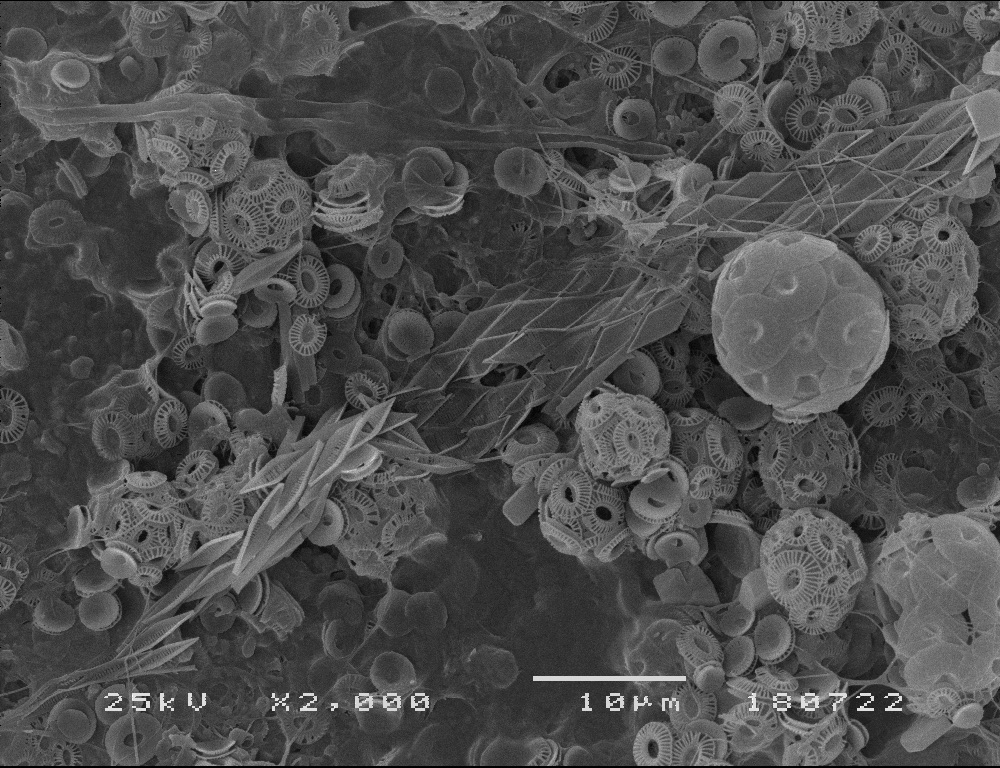We are pleased to announce that our latest DUSTCO paper got accepted to be published in Progress in Oceanography! The accepted version of the paper (not final yet!) is already available here.
In this study we focused on exploring links between the export fluxes of coccolithophores from upwelling affected NW Africa to the the Caribbean, and wind-forced geostrophic variations of the nutricline and thermocline across the tropical North Atlantic. Sampling was undertaken by means of a spatial array of four time-series sediment traps collecting particle fluxes every two-weeks from October 2012 to February 2014, in the context of the ERC-funded project DUSTTRAFFIC.
This is our study area, across the tropical North Atlantic. You can see the location of the sediment trap mooring sites (squares) and main surface currents (arrows) (adapted from Mann and Lazier, 2006 and Pelegrí et al., 2017). The seasonal migration of the Intertropical Convergence Zone was schematically drawn according to Basha et al. (2015).
Why is this relevant?
Being a “Low Nutrient Low Chlorophyl” (LNLC) oceanic region, the tropical North Atlantic provides a potencial benchmark for future primary productivity in the context of an increasingly warmer, stratified and nutrient-depleted ocean due to ongoing climate warming. In other words, our study regions is likely to provide a modern perspective of what might happen to phytoplankton production in the future ocean at higher latitudes in case of persistenting climate-driven ocean warming. As coccolithophores are both photosynthetic and calcifying, they are major contributors to the organic and inorganic oceanic carbon pumps (e.g. Rost and Riebesell, 2004). This means that any changes in their distribution, abundance and carbonate production related to ocean warming has the potential to directly impact the marine carbon cycle. This is one the reasons why it is so important to understand their ecological dynamics and coccolith export production in tropical open-ocean .
This is an image of a coccolithophore bloom that was taken using and Scanning Electron Microscope (SEM), providing a view of the surface of the ocean (10m water depth) at 2000x magnification. This plankton sample was collected offshore Cape Blanc (NW Africa) and represents the north easternmost side of our transatlantic array (site CB).
In our paper, we illustrate how coccolithophores species and seasonal export fluxes showed steep W-E gradients in two main groups:
Upper photic zone (UPZ) species dominated by Emiliania huxleyi and Gephyrocapsa oceanica are most abundant in the mesotrophic surface waters of the Cape Blanc upwelling system off NW Africa. They decline gradually towards the Caribbean, paralleled by increasing surface temperatures and decreasing surface chlorophyll-a.
Meanwhile the abundance of lower photic zone (LPZ) species Florisphaera profunda and Gladiolithus flabellatus increase in the same direction, reaching fluxes up to 3-5 times higher in the western end of the transect compared to the UPZ flora in mesotrophic waters. Adapted to low light conditions, the LPZ species follow the geostrophic wind-forced deepening of the thermocline/nutricline westward in ever lower species diversity towards the Caribbean.
This figure shows the spatiotemporal variation of (a) daily precipitation rates (blue) and wind speed (black line), (b) seasonal mixed layer (MLD) from the NASA Ocean Biogeochemical Model (NOBM) (light blue, 2012-2013), MLD monthly climatology obtained from the in situ data measured by Argo floats (dashed curve, 2000-2018), and sea surface temperature (SST), (c) UPZ/LPZ ratios (light green), sea surface Chl-a concentrations (dark green line) and SST (red line), (c) relative abundance of the most abundant taxa (> 3 %), (d) coccolith fluxes by the UPZ species E. huxleyi and G. oceanica(green), (e) coccolith fluxes by the LPZ species F. profunda and G. flabellatus (grey) and (f) total coccolith export fluxes (black) at sites M4, M2, M1 and CB.
As most ecological and climate models dealing with global ocean productivity only use surface Chl-a concentrations derived from remote-sensing observations, our study highlights the importance of investigating primary productivity along the entire photic zone when projecting the effects of ocean warming on future phytoplankton- and coccolithophore production.
The next question is: how do these wind-forced transatlantic ecological gradients translate into coccolith-carbonate production? And what is the role of transatlantic Saharan dust deposition in all these important biogeochemical processes?
This is our work currently in progress!
Stay tuned :-)


